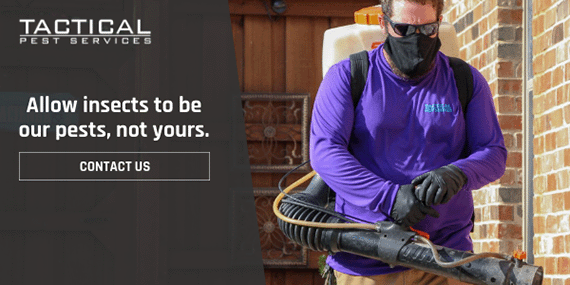It’s easy to become terrified when you hear a buzzing noise and then see a yellow flash in front of your eyes. Bees, wasps, yellowjackets, and hornets can be scary and harmful pests when found close to a home or office. We thought it would be a good idea to discuss some of the distinctions between these common flying creatures and when it is necessary to contact a professional for treatment. Not every bee is bad, and depending on your environment, some bees are beneficial to your garden or plant life.
We will start with some of the more aggressive types of flying pests and then discuss some of the benefits more docile bees can provide to your yard. If you are unsure which kind of infestation you have, it’s always best to contact a professional for an evaluation.
Wasps and Yellowjackets
“Wasps” is the more common name for these types of flying insects and the term “Yellowjacket” refers to a specific species often found in North America. It’s hard to know for sure, but it is estimated there are well over a hundred thousand different wasp species around the world. For example, almost every one of the 1,000+ species of tropical fig trees has its own specific fig wasp that has co-evolved with that fig tree species and pollinates it.
From a taxonomy perspective, wasps are neither bees nor ants but are somewhere in-between. There are certainly peaceful, pollinating species of wasps that exist, but most wasp species are known for their aggressive behavior. Some wasp species gather in colonies and work together, other species are more solitary. If you have ever seen a small wasp nest, these are made for a single wasp and its offspring. What makes yellowjackets particularly terrifying is they work and live in colonies, and are smart enough to target specific targets and coordinate attacks when they feel threatened.
Wasps and yellowjackets build nests in trees, shrubs, protected places such as inside man-made structures, or in soil cavities, tree stumps, mouse burrows, etc. They are primarily composed of wood fiber the insects chew into a paper-like pulp.
Queens emerge during the warm days of late spring or early summer, select a nest site, and build a small paper nest in which they lay eggs. After about 20 days, larvae pupate to emerge as small, infertile females called workers. Workers in the colony take over caring for the larvae, feeding them with chewed-up meat or fruit. By midsummer, the first adult workers emerge and assume the tasks of nest expansion, foraging for food, care of the queen and larvae, and colony defense.
From this time until her death in the autumn, the queen remains inside the nest, laying eggs. The colony then expands rapidly, reaching a maximum size of 4,000–5,000 workers and a nest of 10,000–15,000 cells in late summer. At peak size, reproductive cells are built with new males and queens. Adult reproductives remain in the nest, fed by the workers. New queens build up fat reserves to overwinter. Adult reproductives leave the parent colony to mate. After mating, males quickly die, while fertilized queens seek protected places to overwinter. Parent colony workers dwindle, usually leaving the nest to die, as does the founding queen. Abandoned nests rapidly decompose and disintegrate during the winter. In the spring, the cycle is repeated; weather in the spring is the most important factor in colony establishment.
Hornets
Hornets are very similar to wasps or yellowjackets with only a couple of noticeable differences. Hornets are the largest species of the eusocial wasps, but their appearance is almost identical to yellowjackets. The biggest difference between hornets and wasps is the stinger. Hornet stings are more painful to humans than typical wasp stings because hornet venom contains a large amount (5%) of acetylcholine. Acetylcholine is the chemical that motor neurons of the nervous system release to activate muscles. Hornet stingers can also easily be withdrawn, so are not pulled out of their bodies when disengaging, unlike honeybees.
The hornet lifecycle is very similar to wasps and begins every spring with a new nest founded by a fertilized female known as the queen. She generally selects sheltered places such as dark, hollow tree trunks. Cells are created, eggs are laid, the larva hatches, and eventually matures into adult hornets through metamorphosis. This first generation of workers now gradually undertakes all the tasks formerly carried out by the queen, everything except for egg-laying. At the peak of its population, which occurs in late summer, the colony can reach a size of 700 workers.
Hornets, like many social wasps, can mobilize the entire nest to sting in defense, which is highly dangerous to humans and other animals. The attack pheromone is released in case of threat to the nest. For this reason, many hornet species are considered to be dangerous when around human environments.
Bees
Bees can be just as scary as wasps or hornets but tend to be much less hostile because every bee only can sting once before dying. Unlike hornets or wasps, a honey bee’s stinger will become disconnected from the bee when use, which is a fatal event. Bees have to feel very threatened to sting. Some bees don’t even have stingers! Bees also play a very important role in plant reproduction and their ecological benefits should be considered before tampering with them. For this reason, it’s best to contact a pest professional if you are unsure which kind of bee, wasp, or hornet you are dealing with.
The ancestors of bees are wasps, which are predators of other insects. It’s unclear exactly how the switch from prey to pollen was made, but one theory is the consumption of prey insects which were flower visitors and were partially covered with pollen when they were fed to the wasp larvae. Over thousands of years, this gradual shift became permanent to now modern bees only survive on pollen.
As mentioned earlier, bees play an important role in pollinating flowering plants and bees are the primary pollinators in any ecosystem that contain flowering plants. It is estimated that one-third of the human food supply depends on pollination by insects, birds, and bats. The vast majority of this pollination is accomplished by bees, either wild or domesticated.
Bees also produce a major aspect of human diets, honey. This would only be possible through a complex societal structure. This is achieved through mass provisioning (stocking all the food required for an offspring before laying an egg), complex nest architecture, and perennial colonies with multiple generations cohabiting together. Bees are very smart creatures and, in most cases, are relatively harmless.
The main takeaway from this article is there are lots of different flying insects out there. Just because you hear a “buzz” whisking past your ear, doesn’t mean you need to bug bomb your entire backyard. Some insects, like wasps and hornets, are true pests that need to be removed safely. Other bugs, like bees, might be having a positive effect on your yard and just need to be relocated or left alone. The only way you will know what to do without a doubt is to give Tactical Pest Services a call. We will conduct a comprehensive evaluation of your home, office, or yard and create a detailed plan with transparent pricing to tackle the problem.


